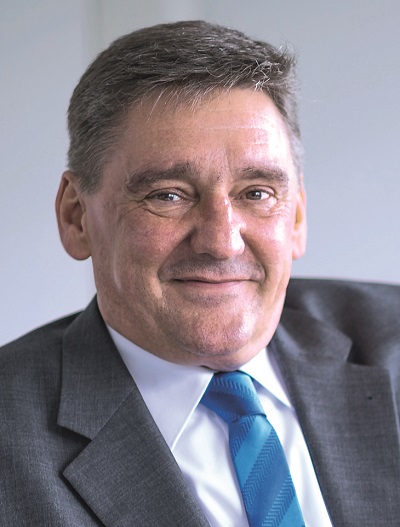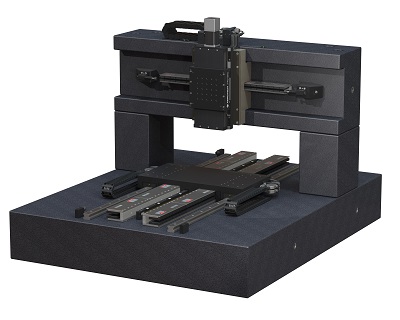
“We are planning to implement five pilot projects for the new IGM linear tables in the current fiscal year.” -- Norbert Ludwig
Precision machining starts with exact positioning. With the IGM motion platform, the motion control specialist Aerotech has developed a new series, which is significantly more flexible and scalable than conventional positioning tables. The development was driven by Norbert Ludwig, Managing Director of Aerotech GmbH in Fürth. He provided the impetus for such systems to enter the German markets. Aerotech has revived a concept already contemplated before. In an interview, Norbert Ludwig (NL) explains to International Metalworking News for Asia (IMNA) the concept behind it and his market strategy.
IMNA: Mr. Ludwig, with IGM you have developed a new design for motion components in machines, what exactly does this involve?
NL: The idea behind IGM, Integrated Granite + Motion, is as simple as it is effective. We no longer position a complete linear adjuster on granite, but its individual components, so that the guide, drive and measuring system are mounted directly on the granite and not via the detour of a complete adjuster. We are thus offering motion components as a product group for the first time and no longer as a purely special solution for the customer as we have done so far.
IMNA: How does the IGM motion platform differ from other multi-axis motion systems?
NL: In the classical design, linear adjusters are screwed onto a granite base, i.e. onto a flat surface as a counter mass, in order to be able to safely accelerate and move large masses. Although IGM motion platforms have already been manufactured in special production, due to our flexible component concept, however, we can apply this one-off production characteristic variably to the series, and, using the components, we assemble an application-specific positioning table according to customer requirements. Nevertheless: IGM must not be understood as a finished product, but as a concept to show how customer-specific motion systems can be constructed flexibly. We can, for example, show how the axes and guide rails can be arranged in order to design the system according to the customer´s requirements.
IMNA: You mentioned flexibility in the beginning, how does this flexibility express itself?
NL: The IGM is more flexible and scalable than conventional positioning solutions, because the individual components can be selected in such a way that they are optimally matched to the dimensions and masses of the objects to be moved. The dimensions and profile widths are already predefined for previous adjusters. Let´s take the guide rails as an example. We can select the distance and profile of the rails in a way that the moving object is guided almost perfectly. The same applies to the length, i.e. the positioning range, of course.
IMNA: And what are the main advantages?
NL: The advantages are obvious: On the one hand, we need less installation space for the component design of the linear tables, as the overall height is significantly reduced. On the other hand, the accuracy is increased. With every mechanical interface – adjuster, guide, linear slide, screw connection, etc. – there are certain tolerances. If we omit a component, the rigidity increases and thus ad hoc the accuracy. The elimination of intermediate plates also means that the resonance frequency is higher, so that we achieve better response behaviour with strong acceleration of the axes.
IMNA: How does the mechanical engineer benefit when using IGM?
NL: For discrete adjustment systems which are not available from the standard product portfolio, he needs all individual adjusters in a special design. This significantly increases the time and effort required for the processes from design to production. Mechanical processing must also be redesigned, including the creation of new machine programmes. This takes time, of course.
The IGM, however, does not require a new design for every linear adjuster. For example, a 1200 mm x-axis with 800 mm y-axis can be quickly implemented once the design of the granite plate has been determined. Within certain limits, we can adjust the design very well to the conditions of the designer.
Nevertheless, you should not ignore that a high flexibility also has disadvantages, because the design is fixed in this case. For example, the y-axis cannot simply be extended in retrospect, because this would result in a new design. And because of the installation, the service can only be carried out on-site at the customer´s premises – the customer cannot replace any components on his own.
IMNA: What does this mean in practical terms?
NL: Usually, customer applications can be found in precision measuring and machining technology with adjustment ranges of up to 2 metres. If, for example, standard adjusters are no longer able to work at a length of 1 metre, because the milling machines can only process longer profiles with a great deal of effort, this would not be a problem for an IGM system. You can build any length, 1.50 m, 1.80 m etc. – without having to redesign it again. In some applications, the granite plate is up to 10 metres long. An example of this is the cutting of glass substrates, where the machine bed measures up to 10x4 metres. Although this is not our area of application, scalability is generally available.
IMNA: Is IGM a strategic product for Aerotech?
NL: Definitely, because it strengthens our competitiveness by shortening delivery times and increasing flexibility. The signal from our headquarters in Pittsburgh, USA points towards decentralisation. The design of the motion system is developed by designers in the USA, but the parts are procured in Germany. Granite plates, for example, have an extremely high volume weight with a low intrinsic value, so it is more profitable to develop local supply chains than to transport the plates by air freight halfway around the world. In the future, we will purchase the granite on-site and then assemble the complete system at our plant in Fürth – where we are virtually a pilot for decentralised finishing of our products. This saves customers a considerable amount of time, with delivery times halved from 30 weeks to around 15.
IMNA: Is an expansion of your capacities at the plant in Fürth planned in this context?
NL: Definitely yes. The customer-specific configurations of the IGM positioning systems are to take place in Fürth in the future and may require an expansion. Our decentralised market strategy is also accompanied by a more personal customer service, for which alone we need additional capacities in consulting and service.
IMNA: Last, but not least, what are your sales targets for the current fiscal year and what role will IGM play as a strategic product?
NL: In the first year, our current fiscal year just started in July and will end in June 2019, we plan to build 5 pilot systems here in Germany. This corresponds to about 1 percent of our total sales. The challenge is first of all to develop the qualifications of individual employees and later to develop an appropriate team in order to be able to deliver larger quantities on a customer-specific basis. Our medium-term goal with IGM is a 10 percent share of sales. The location in Fürth, which we just moved into at the beginning of 2017, is designed for further expansion, e.g. for an additional assembly hall.
IMNA: For which areas do you predict the use of the first five IGM systems?
NL: We see possible areas of application mainly in high-precision measurement technology and laser material processing. There are already two interested parties from the areas of measurement technology and laser material processing for possible pilot projects. In addition to a price advantage, because IGM will be less expensive than discrete systems, they mainly expect a competitive advantage thanks to shorter delivery times.

Aerotech´s new IGM motion platforms require less installation space and can be adjusted and scaled according to customer specifications.
Nike Air Max 97













